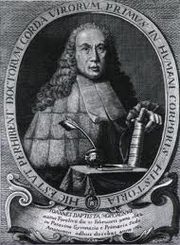This article is part of the series "A Moment in History" where we honor those who have contributed to the growth of medical knowledge in the areas of anatomy, medicine, surgery, and medical research.

Giovanni Batista Morgagni
Giovanni Battista Morgagni (1682 - 1771). Italian anatomist, physician, and pathologist, Morgagni was born in the city of Forli. He started his medical studies at the University of Bologna, graduating in 1701 with a degree in Medicine and Philosophy. In 1712 he became a professor of anatomy at the University of Padua, Italy, 175 years after Andreas Vesalius. Morgagni was offered and accepted the Chair of Anatomy in 1715 at the University of Padua. Although Morgagni held a position at the anatomy department of the University of Padua, his name is associated mostly with his pathological studies.
Morgagni was interested in the works of Theophile Boneti (1620 - 1689), who started analyzing the correlation between post-mortem anatomical findings and diseases. He tried to establish a relation between the disease and the cause of death. In 1761 Morgagni published his most influential work "De Sedibus et Causis Morburum Per Anatomen Indagatis" (On the Sites and Causes of Diseases, Investigated by Dissection). His work was essential for pathological anatomy to be recognized as a science in itself.
Morgagni was elected to become a member of several Academies of Science and Surgery: The Royal Society of London, The Academy of Science in Paris, The Berlin Academy of Science, and the Imperial Academy of Saint Petersburg in Russia. He is remembered today by several eponyms in anatomy and pathology:
- Morgagni's caruncle or lobe, referring to the middle lobe of the prostate
- Morgagni's columns: the anal (or anorectal) columns
- Morgagni's concha, referring to the superior nasal concha
- Morgagni's foramina: two hiatuses in the respiratory diaphragm allowing for passage of the superior epigastric vessels
- Morgagni's hernia: an hiatal hernia through Morgagni's foramen, in the respiratory diaphragm
- Morgagni's ventricle: an internal pouch or dilation between the true and false vocal cords in the larynx
- Morgagni's nodules: the nodules at the point of coaptation of the leaflets (cusps) of the pulmonary valve. Erroneously called the "nodules of Arantius", which are only found in the aortic valve
Sources:
1. "A Note From History: The First Printed Case Reports of Cancer" Hadju, S.I. Cancer 2010;116:2493–8
2. "Giovanni Battista Morgagni" Klotz, O. Can Med Assoc J 1932 27:3 298-303
3. "Morgagni (1682 -1771)" JAMA 1964 187:12 948-950
Original image in the public domain, courtesy of National Institutes of Health.



